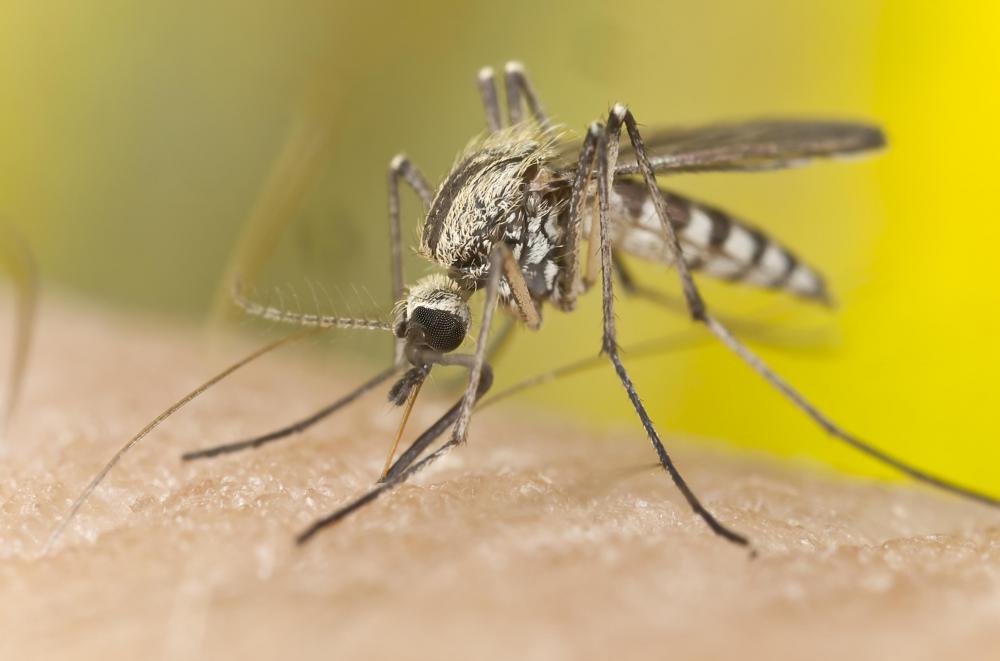At AllThingsNature, we're committed to delivering accurate, trustworthy information. Our expert-authored content is rigorously fact-checked and sourced from credible authorities. Discover how we uphold the highest standards in providing you with reliable knowledge.
What is the Lifecycle of a Mosquito?
Knowing something about the lifecycle of a mosquito can empower you to prevent them from reproducing in your backyard. A mosquito goes through "complete" metamorphosis, which means it is an egg, larva, pupa, and finally an adult. Depending on the species, climate, season, availability of blood, and temperature, a mosquito will take anywhere from a week to a month to complete its metamorphosis.
Every mosquito starts out as one tiny egg amongst hundreds that comprise a "raft" of floating ova. After a large blood meal, the adult female lays this batch of eggs in stagnant water. Appropriate water sources could be a sewer, ditch, puddle, birdbath, wheelbarrow, rain gutter, untreated swimming pool, water fountain, or even ocean tide pools. The white eggs incubate for 1-6 days before hatching into squirming larvae.

Larvae look like thin worms that twitch constantly just below the surface of the water. They enjoy the light, heat, and air close to the surface. Now the mosquitoes eat bits of food such as rotting leaves, animals, or sewage to give them strength to molt four times. Each time they molt, they shed their small, tight layer of skin and emerge slightly larger.

Finally, after another week, the larvae become pupae with their fourth molting. Pupae have larger heads and a small tail, so they're nicknamed tumblers. They also stay underwater, yet breathe air. Small tubules, called siphons, reach from their lungs to break the surface of the water like miniature snorkels. They develop wings without eating any more food.

A few days later, the larvae swim to the top of the water and balance on their feet to stay in open air. Here, they dry out their wings and harden their exoskeleton in preparation for flight. They're mature adults. They'll live one to three more weeks, completely above water. Females live 2-3 times longer than males because they must eat more blood in order to lay eggs.
Female mosquitoes suck the blood of humans, cows, sheep, horses, birds, and even amphibians in order to build up enough nutrients to lay eggs. Males, though, only drink plant nectar. The female can lay several batches of eggs, 10-14 days apart, before she dies. Then the cycle repeats itself.
Frequently Asked Questions
What are the stages of a mosquito's lifecycle?
The mosquito lifecycle comprises four stages: egg, larva, pupa, and adult. Eggs are laid on water or damp surfaces and hatch into larvae, which live in water and molt several times. Larvae transform into pupae, a non-feeding stage where they develop into adults. Adult mosquitoes emerge from the pupal case to begin their aerial life.
How long does it take for a mosquito to develop from egg to adult?
The development time from egg to adult mosquito varies by species and environmental conditions, but typically ranges from 5 to 14 days. Warmer temperatures generally accelerate development. For instance, Culex mosquitoes can complete their lifecycle in as little as seven days at optimal temperatures, according to the Centers for Disease Control and Prevention.
Where do mosquitoes lay their eggs?
Mosquitoes lay their eggs in stagnant or slow-moving water, or on moist surfaces prone to flooding. Some species, like the Aedes mosquito, prefer small containers of water, while others, such as the Anopheles, may lay eggs in larger bodies of water like swamps or marshes. The choice of breeding site is crucial for the survival of the eggs.
Can mosquitoes breed in any type of water?
While mosquitoes are often associated with dirty water, they can breed in a variety of water sources, including clean water. However, the presence of organic material can provide nutrients for the larvae, making certain types of stagnant water, such as that found in discarded tires or bird baths, more conducive to mosquito breeding.
How do mosquitoes feed and what is their role in the ecosystem?
Female mosquitoes feed on blood to obtain proteins for egg production, while both males and females also feed on nectar for energy. Mosquitoes play a role in the ecosystem as pollinators and as a food source for other animals, such as birds and fish. Their larvae also help break down organic matter in aquatic ecosystems.
What methods can reduce mosquito populations effectively?
Effective mosquito population control includes eliminating standing water where mosquitoes breed, using insecticides, introducing natural predators like fish that eat larvae, and using mosquito traps. Additionally, personal protection measures like bed nets and repellents can reduce the risk of mosquito bites. Community-wide efforts are often necessary for significant impact on mosquito populations.
AS FEATURED ON:
AS FEATURED ON:













Discuss this Article
Post your comments